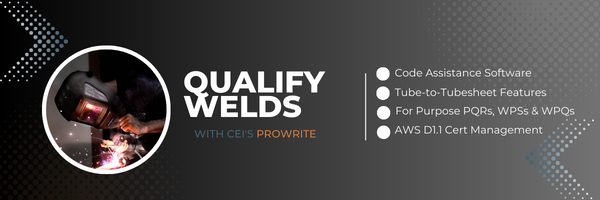ASME Section VIII, Division 1 2021 Edition inserted a new paragraph UW-28(b) regarding Tube-to-tubesheet welding. In this new paragraph, the code user is directed to qualify Tube-to-tubesheet welding procedures in accordance with either paragraph QW-193 OR QW-200 in ASME Section IX. Specific Tube-To-Tubesheet qualification requirements were present in older versions of Section IX than in 2021, but how to make use of these requirements may have been a little unclear in Section VIII, Division 1 until 2021.
In this blog, we'll provide some insight into the scenarios that may affect qualifying your Tube-to-tubesheet welds in accordance with ASME IX. Let’s dive in.
.jpg?width=3200&height=2133&name=syd-mills-sPl7FgBalxI-unsplash%20(1).jpg)
So, What's the Direction Provided in Section IX?
Section IX has options for both procedure and performance qualification based on mockups or based on groove weld or fillet weld qualifications.
If the applicable code of construction (in this case Section VIII, Division 1) requires the mockup rules, then QW-193 applies. If the applicable code does not, then the mockup per QW-193 is still an option but groove weld requirements or fillet weld requirements may be used instead.
What's IX Say About Procedure Qualification?
To reiterate, UW-28(b) requires the Tube-to-tubesheet procedures to be qualified in accordance with Section IX QW-193 or QW-200. The “or” is important here because it gives the user the option to do mockups or not.
Also, guidance is provided in Section IX QW 202.6. It reiterates that if the code of construction requires mockup qualification, then the user must comply with QW-193.1. However, Section VIII does not require QW-193 but instead lists it as an option. In this case, QW 202.6 would then allow the user to still use mockups per QW-193 OR to meet the groove weld requirements of QW-202.2 and 202.4 OR to meet the fillet weld requirements of QW-202.2(c). The fillet weld requirements are only allowed to be used for fillet welds on non-pressure retaining welds.
The essential variables for Tube-to-tubesheet welding per QW-288 act as an addition to the other essential variables, based on the process(es) used, as specified in Tables QW-252 through QW-267.
For example, if GTAW was used for the Tube-to-tubesheet procedure, the variables from both Table QW-256 and QW-288.1 would apply. It's also important to note that Table QW-288.1 applies to processes other than explosion welding and Table QW-288.2 applies only to the explosion welding process.
The language in QW-288 makes it sound like the paragraph only applies if QW-193 is used, which may be clarified in a future version of the code. But consider this: using the additional variables in QW-288, anything would be conservative by adding further limits on the qualification. Also, the language surrounding the performance qualification per QW-387 suggests the additional essential variables are unaffected by the application of QW-193 or not.
What About Performance Qualification?
While UW-28 speaks to procedure qualification, UW-29 in Section VIII, Division 1 speaks to performance qualification.
UW-29 does not currently have any explicit requirement on Tube-to-Tubesheet performance qualification, so the code user relies only on Section IX QW-387. The performance qualifications are very analogous to the procedure qualifications. Let’s see how.
If the applicable code of construction (in this case Section VIII, Division 1) requires the mockup rules, then QW-193 applies. If the applicable code does not, then mockup per QW-193 is still an option; however, groove weld requirements or fillet weld requirements may be used instead (the fillet option was added in the 2021 edition of Section IX).
Likewise, the essential variables in Table QW-388 act in addition to the essential variables for Welder Performance Qualification from Tables WQ-352 through QW-357 and the essential variables for Welding Operator Performance Qualification from QW-360.
But is understanding the code in Section IX enough to ensure your welds meet requirements?
What Weld Procedure Resources & Tools Exist Today?
In the same manner that Section VIII, Division 1 UW-28(b) makes QW-193 mockup rules optional, so does weld procedure software like CEI’s ProWrite. Here’s how it works:
- The welding engineer, CWI or fabricator who is using ProWrite, may qualify the procedures based on QW-193 or not as described above. The same applies for qualifying welders and operators.
- The procedures based on the Tube-to-Tubesheet PQRs then take into consideration the additional variables per QW-288 to help guide the user on the allowable ranges that do not require requalification. And likewise, welders and operators can be easily matched with the procedures based on their own performance history, considering the additional variables in QW-387.
Bottom line--software exists today that can not only make understanding these changing guidelines easy to understand but easy to implement as well--in a few short clicks.
For more information about ProWrite's latest Tube-to-tubesheet feature and to see a quick demo about how it’s used in the software, click here.
And, if you're looking for online training to better understand code-assistance software from the experts who design it, consider using a CEI product in conjunction with the ThinkTank Academy.



Leave a Comment